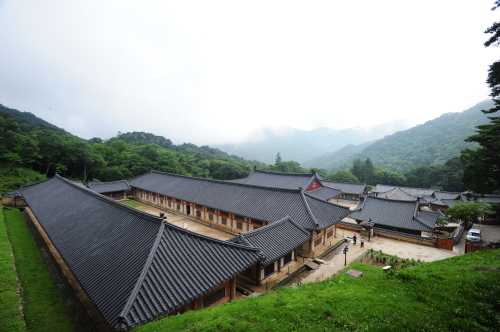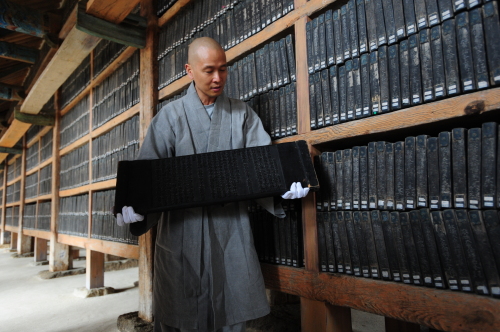KBS special documentary looks for ways to practice Buddhist teachings in daily lives
HAPCHEON, South Gyeongsang Province ― Haein Temple, deep inside the folds of Mount Gaya in South Gyeongsang Province, is known for housing arguably the world’s most comprehensive and oldest intact Buddhist canon, the Tripitaka Koreana.
Visitors have been prohibited from entering the Janggyeong Panjeon, the depository for the Tripitaka Koreana, located in the deepest place of the temple. The tripitaka, also known as Palman Daejanggyeong, was inscribed in UNESCO’s Memory of the World in 2007 and its depository was earlier designated as a UNESCO World Heritage site in 1995.
 |
A view of the Janggyeong Panjeon, or the depository of the Tripitaka Koreana, at Haein Temple in Hapcheon, South Gyeongsang Province. (KBS) |
However, on a rainy Thursday last week, the lock of the wooden door to the depository was open to the press for just 30 minutes and the state-run broadcaster KBS was allowed to shoot a scene for a four-part documentary series on the Tripitaka Koreana.
KBS plans to air the program in October, celebrating the 1,000th year of the creation of the “Chojo Daejanggyeong” ― the first edition of the Tripitaka Koreana, work on which began in 1011 during Goryeo Dynasty (935-1390). The leaders of Goryeo sought to protect the kingdom from the Mongols through Buddha’s power.
After the first edition was lost to fire during a Mongol invasion in 1232, King Gojong of Goryeo ordered to recreate the tripitaka. It took 16 years until 1251 to finish carving its more than 52 million Chinese characters onto 81,258 wooden printing blocks.
The tripitaka preserved at Haein Temple is the second edition.
“A lifelong dream of monks here at the temple is to enter the Janggyeong Panjeon but most of them cannot realize that dream before they die. Except for rare cases such as a special visit by scholars for research, no one can enter here,” said Seong-an, a monk at the Haein Temple who takes care of the depository and regularly checks temperature and humidity there.
“Janggyeong Panjeon is the only place in the world that a UNESCO World Heritage and a UNESCO Memory of the World are housed in the same place,” said Seong-an.
 |
Seong-an, a monk at Haein Temple, shows a wooden block of the Tripitaka Koreana inside the Janggyeong Panjeon at the temple in Hapcheon, South Gyeongsang Province, Thursday. (KBS) |
The wooden depository ― consisting of four storage halls which together form a rectangle ― is known for its ingenious preservation techniques based on the simple design of the building.
“The windows on the north and south sides of the two main halls have different sizes so that the outside air comes into the hall, circulates inside the hall once and goes out the opposite way. Ventilation is the most important for the preservation of wooden blocks,” he said.
To help adjust humidity, the clay floor was filled with salt, lime, sand and charcoal.
“You can find no spider web or bird’s nest in the storage hall, which still remains a mystery,” he said.
Then, after wearing a pair of white gloves, he carefully took out one of the wooden printing blocks and showed it to the press.
The Chinese characters were carved on both sides of the wooden block.
“The letters were carved obliquely. This was to prevent the excessive ink from remaining on the block after printing,” the monk said.
After the short visit to Janggyeong Panjeon, KBS documentary department director and producer Choi Young-keun held a press conference on the purpose of the special series on the Tripitaka Koreana to be aired in October.
The title of the program will be “Dharma,” or the truth in Sanskrit. After describing what the Tripitaka Koreana is in the first episode, the three episodes will compare the practices of three main branches of Buddhism ― Theravada, Tibetan and Zen ― each with a medical center in the U.S., the world’s largest particle physics laboratory in Europe and a Catholic convent in Austria.
“While I can frequently witnessed people reading the Bible on the subway, I rarely see people reaching Buddhist scriptures. Even though the content of the Tripitaka is so rich, it seemed isolated from the public,” Choi told reporters.
“I wondered why, and wanted to show how the content and wisdom of the Tripitaka Koreana could help us solve our problems in real life.”
The KBS team has been working on the documentary since May 2010.
“There is no narration in the program, which is quite challenging for a documentary. But I intended it so that viewers could be more engaged in their own interpretations,” Choi said.
Meanwhile, celebrating the millennium of the Tripitaka Koreana, Hapcheon County will hold a 45-day international festival from Sept. 23 to Nov. 6 to exhibit the Buddhist canon, introduce woodcut works by 60 international artists and hold an academic forum to discuss the scientific value and the re-evaluation of the tripitaka.
On Sept. 24, the Haein Temple is to hold “Haein Art Day” event, opening the temple’s Seon Center to the public for meditation for the first time in the temple’s 1,200 year history. The event will also include exhibitions that show modern artists’ works in harmony with nature and Buddhism.
By Kim Yoon-mi (
yoonmi@heraldcorp.com)









